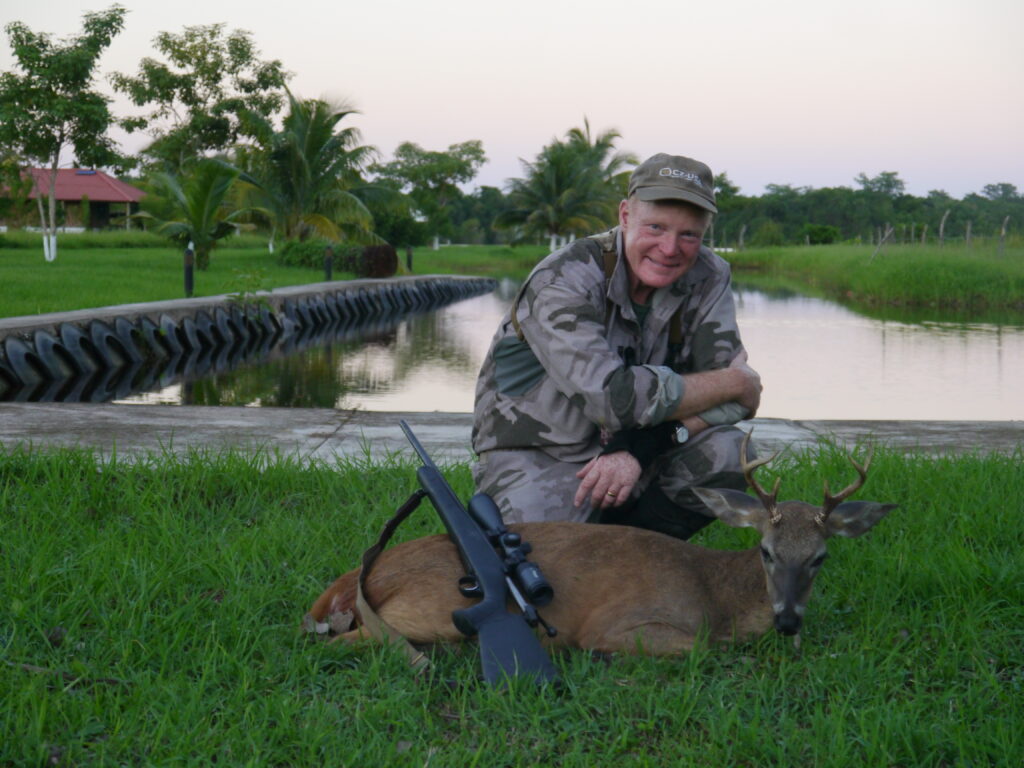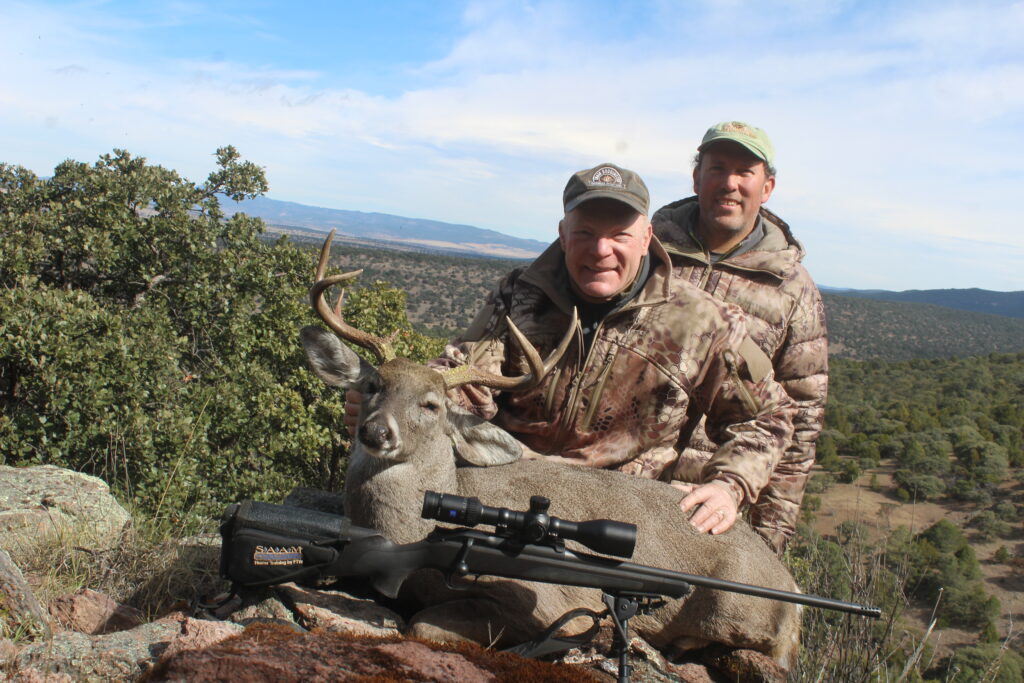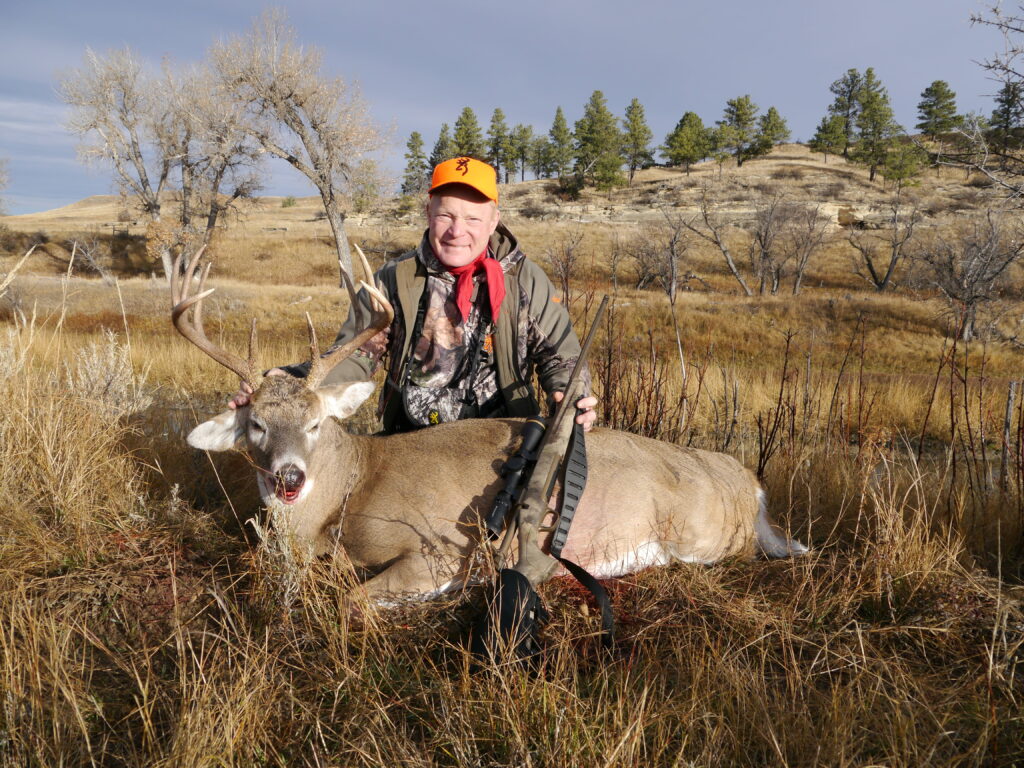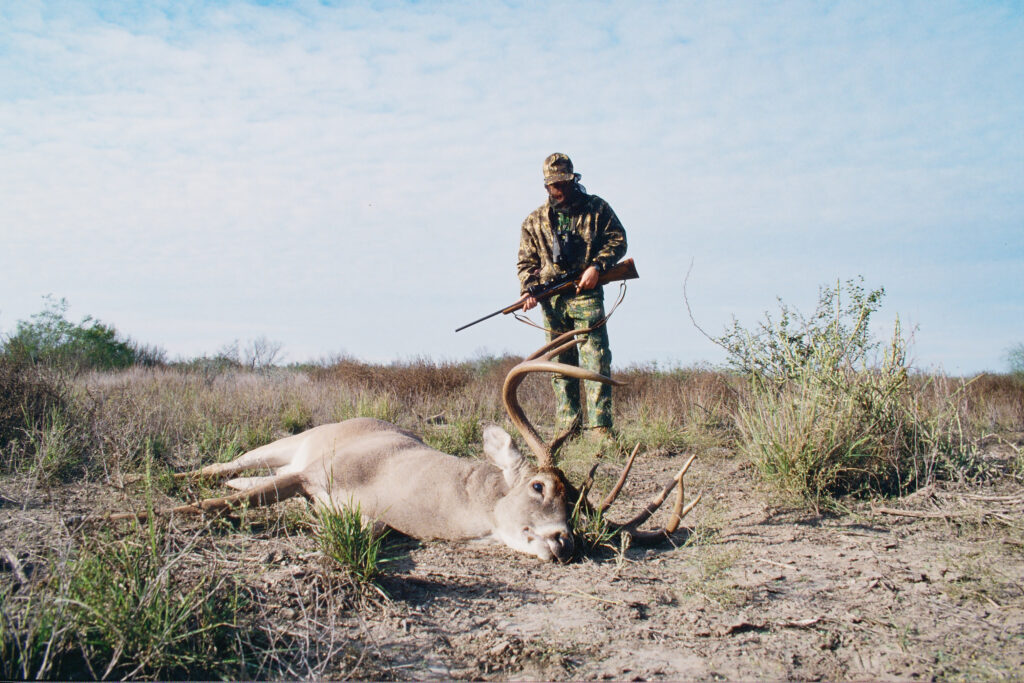So Many Whitetails, So Little Time
The Coues, Texas, Southeastern, Midwestern, Northeastern and Northwestern of North America
By Craig Boddington
Originally published in the September/October 2024 Issue of Safari Magazine.
The whitetail deer is the world’s most numerous large wild mammal. There are some 35 million in North America alone, ranging from the treeline in Canada to the Panama Canal.
To many of our 10 million American deer hunters, it doesn’t matter which deer we pursue: The whitetail in our backyard, those with the biggest antlers or those that give us the most challenge or are simply for the freezer. Most, perhaps, all of the above.
Not all authorities agree, but there are about 38 recognized subspecies of whitetails, as many as 30 within North America. No matter how long you work at it, you can’t hunt them all. Here in the U.S., the tiny Florida Keys whitetail is long protected. There are other races that are not hunted, and the majority below the Panama Canal are not open to sport hunting. They are all species of Odocoileus virginianus, and all look like whitetails: Big, white fluffy tails that flag in alarm and antlers with fighting tines rising vertically from a main beam. All are crafty and cover-loving and a lot of fun to hunt.
SEPARATING THE HERD
Except for the few isolated races, broad hybrid zones exist between all the subspecies. It makes them tough to tell apart. Thankfully, there’s not much sense in trying. A nice buck is just that and a great prize. However, whitetails are a fine example of Bergmann’s Law: Within a species, the farther from the Equator, the larger individuals grow. It’s a practical matter of heat retention in colder climates.
Although genetics, food and minerals play a major role, the largest whitetails can grow the largest antlers. With intensive management, Texas whitetails belie this a bit, but in general, it’s true. Small whitetails from Florida cannot compete with Canadian giants. Traditionally, hunters’ record books lumped all whitetails together as the “Virginia deer” with one exception: We traditionally separate the Coues deer (O. v. couesi). This is appropriate because this small, gray, desert deer of the Southwest is different in appearance, habitat and habits.
Fine, but its separation was based on a taxonomic mistake. When identified by U.S. Army surgeon and ornithologist Elliott Ladd Coues, it was believed “his” deer was a separate species. Not until the 1920s was the Coues deer recognized as just one of many whitetail races. Love to hunt Coues deer, happy for the distinction, but it never seemed fair that whitetails from the Southeast had to compete with big deer from the northern woods or western Canada.
Our SCI Record Book started with categories for Coues deer, lumping the rest. From the start, our Record Book was intended to be a global reference. At that time in the 1970s, little was known about whitetails south of the U.S., but we did have categories for Mexican and tropical whitetails. As North American chair for our fledgling records, I felt this was inadequate for such a large tribe. With the approval of Committee colleagues, I set out to divide Canadian and U.S. whitetails into regional categories.
Although I studied references and maps, I don’t pretend these divisions were hard science; hybrid zones are huge, and animals don’t care about political boundaries. Still, I think what we came up with was pretty good: Coues, Texas, Southeastern, Midwestern, Northeastern and Northwestern. Naturally, I wanted to hunt all of them someday. To this day, I have not taken a Northeastern whitetail.
To some extent, whitetails have become my Frankenstein monster: The closer I get, the more distant the goal. As knowledge increased, so did whitetail categories. After a long closure, when Oregon’s isolated Columbian whitetail reopened, we added a category. Later, we added a whitetail category on Quebec’s huge Anticosti Island. I hunted there in 2017 and shot a small buck. Tough hunting in the thick forest just about froze my tail off.
More recently, our Records Committee tackled the tough task of separating the several races of Mexican whitetails. The Coues, Carmen Mountain and Texas whitetail all range from the U.S. deep into Mexico. Likewise, the Central American or tropical whitetails (multiple races) range from the Yucatan Peninsula down to the Panama Canal. One of the most enjoyable whitetail hunts I ever had was at Nic Te Ha in Campeche. Hot, tropical and fascinating. Good bucks are often tiny with “two-by-two plus eye guards” at full maturity. My buck weighed maybe 60 pounds. The Florida Keys deer is the smallest whitetail, and I can’t imagine they’d be much smaller!
Fifty years after its inception, our Record Book remains a living system, adjusting as knowledge increases. Aside from desiring completeness and accuracy, part of the impetus for adding Mexican categories is the Thummler Award for taking “all” of the Mexican deer. The idea is to give recognition and place value on it, thus increasing conservation efforts for deer in remote corners of Mexico. Of necessity, the “new” Mexican whitetail categories are regional.

Just before COVID-19, I did a wonderful hunt for the Mexico Central Plateau whitetail. From a scientific standpoint, this category includes two subspecies: O. v. mexicanus in Central Mexico; and O. v. miquihuanensis farther north. Two more “new” whitetails are the Gulf Coast and Pacific Coast whitetail. At this writing, hunting opportunities for outsiders are limited. Give recognition, place value and both conservation and opportunities will follow.

Our SCI Record Book recognizes more than a dozen North American whitetail deer varieties. Few of us will be so driven as to pursue them all. And, since all are whitetails, visual differences are subtle. However, since they’re whitetails, all are crafty, challenging and interesting. Whatever our own backyard deer happens to be, we know them and how to hunt them. With “other” whitetails, part of the fun is seeing and hunting them in different environments. In the U.S., many can be hunted do-it-yourself on public land. And they are deer, not wild sheep. When guided hunts are preferred, most whitetails can be hunted at a modest cost.
STAND HUNTING
Across the huge range of the whitetail deer, terrain and vegetation vary widely. We know how to hunt our backyard deer, but as we venture farther afield for “new” whitetails, it is wise to keep an open mind!
My backyard whitetails are in southeast Kansas —Midwest whitetails, if you will. Since I’m 15 miles from Oklahoma, I suspect my deer are texanus, not the larger Kansas whitetail (O. v. macrourus). No matter, I know how to hunt them today.
When I bought that farm 20 years ago, I only thought I knew how to hunt whitetails. Unlike many, I didn’t grow up hunting whitetails. I’m from Kansas, but we didn’t have a deer season when I was young, so my early deer hunting was farther west. Later, I hunted whitetails in various places: Texas, Montana and Wyoming, western Canada, the Southeast, and Coues in Arizona and Mexico. I even guided for whitetails in eastern Colorado.

My farm isn’t wall-to-wall agriculture with obvious creek bottoms and shelter belts. Instead, it’s climax oak forest on rolling ridges. No glassing vistas, no long-range encounters. The same stuff millions of whitetail hunters deal with and understand. But close-cover whitetail hunting was foreign to me. The first couple of seasons were tough. Over time, I figured out where to put stands and learned what stands were likely to produce under certain conditions.
With thick cover and several inches of crunchy leaf litter, we have no choice but to hunt from stands. At heart, I’m a Western hunter, so that’s not my preference. Like millions of whitetail hunters, we hunt from stands because they work. By now, we’ve taken perhaps 200 bucks and as many does. Every single one from stands.
After a couple of slow days, our hunters often ask about doing drives or still hunting. Well-planned deer drives work, but our farms aren’t big enough. I have no interest in sending our deer to neighbors. As far as still-hunting (stalking), our woods are just too noisy. If we’d ever get a foot of fresh snow, maybe I’d sneak into Bucky’s bedroom and try to surprise him. In the last 20 years, we’ve barely seen a skiff of snow during deer season.
Like it or not, hunting whitetails from stands is sound. The Big Woods adage “he who sits the longest gets the deer” is true. I admire our hunters who can sit all day, but I’d be the first to admit I can’t do it, and I sure don’t demand that our hunters do it. By coming in at midday, we miss midday movement — there’s often more than we think — and also let the deer pattern us: They figure out we smelly humans leave the woods in late morning.
For me, sitting all day, although effective, isn’t much fun. It’s supposed to be fun, so sit as long as you can and then hang in for a few more minutes. I did whitetail hunts in western Canada, where the drill was to get dropped off at a blind before dawn and picked up after dark. The advantage is that there is short daylight, not much more than eight hours. I can do that if I must, but I don’t like it. Especially up there in the bitter cold. I took a couple of nice bucks up there, but never a giant. I don’t think I want one badly enough to do that kind of hunting again.
In Kansas, we use a mix of treestands and “Texas-style” box blinds on platforms. Both have advantages and disadvantages. An enclosed blind allows more movement (for fidgety folks like me), and they also control scent somewhat. I can sit longer in a blind than I can in an open treestand. Also, I can cheat by taking a book. Just understand: Effective stand hunting is not relaxing. It’s hard work, concentrating and paying attention. If you’re reading or messing with your phone, you’re screwing up, and you’re going to miss seeing deer.
Many of us are nervous about elevation, and some of us have no business climbing ladders, but overall, I think treestands are more effective than blinds. You can hear better, and that’s important in our crunchy leaves, and you will see more. Also, you can shoot in any direction, although you may need to be a contortionist to get turned around. It’s essential to use a safety harness in treestands, and you are exposed, so you must sit still and resist playing on your smartphone.
Treestands are also colder. The temp doesn’t have to be low to get cold sitting still, and the slightest breeze creates wind chill. My friend Conrad Evarts was filming me on a stand that was up on my highest Kansas ridge. I was in a tall single-seat ladder stand, and he was over my left shoulder on a seat. It was 18 degrees, and no deer were moving. The wind was coming up. Neither of us wanted to be the first to quit, but I thought I might freeze. Finally, Conrad leaned down and said, “Boss, I don’t know what I did to piss you off, but if you just let me out of this tree, I’ll make amends.” For stand-hunting, dress warmer than the temperature suggests.
STILL-HUNTING, CALLING, RATTLING
Counter-intuitive, “still-hunting” is not sitting still but moving ever-so-slowly, trying to spot a deer before it spots you. Honest, this is not my strong suit. I’m clumsy and noisy. The odds are with the deer. However, with good snow, the odds improve a bit. A couple of years ago, I was in spike camp in Alaska with a New Yorker, Dave Dressler. He spun tales of still-hunting and tracking deer in the Adirondacks. I was fascinated. Lanny Benoit achieved national fame for deer-tracking exploits in the big woods of his native Vermont and northern Maine.
All I can say is, “I’m unworthy.” Still-hunting is the way deer are hunted on Anticosti Island. Hunters are assigned marked trails. When I was there, we had fresh snow and ideal conditions. In that year, the population was down from a bad winter, so success was low. But I should have gotten a nice buck. I hadn’t gone far down my assigned trail when I saw big, smokin’-fresh tracks. I was already making a huge mistake: I had the rifle slung, anticipating a several-hour hike. I stopped and was getting the rifle off my shoulder when the buck launched from behind a fir tree 10 yards ahead. He sailed over the trail, long gone before I could get the rifle up. I was unready and completely outclassed.
I have had success still-hunting whitetails along creek bottoms in eastern Colorado and elsewhere in the West. My best Kansas buck was taken by still-hunting a deep canyon system. That was in far western Kansas, 400 miles from my farm, a different, almost treeless world. When conditions allow, there is no harm in trying, but understand that the odds stay with the deer. The biggest challenge: It’s nearly impossible to move slowly enough.
I believe in calling and rattling antlers. Like all calling, nothing works all the time and you never know when a buck might be receptive. I carry a Rodd Madison grunt call. It has pulled in bucks, and it’s also the best thing I know to stop a moving buck for a shot. Rattling antlers can work anywhere, but it is primarily a Texas technique. The first time I saw a buck come to antlers was with Texas gun writer and whitetail legend John Wootters doing the rattling. Much later, great whitetail hunter Michael De Witt showed me his rattling technique. It’s not that it won’t work anywhere else, but it’s best to have a high buck-to-doe ratio and pre-rut or rut conditions.

GOING WESTERN
Stands can work almost anywhere whitetails are hunted. It’s just that vistas and distances change. In my corner of Kansas, we have two dozen stands. One, over the largest food plot, might offer a 300-yard shot, but our average shot is 100 yards. I have no idea how many stands Georgia buddy Zack Aultman has on his pine plantation. Not sure he knows.
However, when I think of Western whitetail hunting, I think about spot-and-stalk hunting—emphasis on “spot” — with good optics. I started hunting Coues deer in the late 1970s and fell in love with the desert mountains and these pretty little deer. Once, during a rainstorm in Sonora, we ran into a nest of bucks and shot a nice one at less than 40 yards. With Coues deer, this is rare. Small deer in big country, Coues deer offer the most optics-intensive hunting I know and some of the longest on-average shooting.
Find them, read the ground, stalk. I learned from the best: First Marvin and Warner Glenn, then Duwane Adams and Kirk Kelso. Arizona Coues deer hunters essentially invented glassing with big, tripod-mounted binoculars. They exported the technique to adjacent Mexico and then to other areas and animals.
Glassing does not apply to much whitetail hunting: You must have vistas to glass. In my part of Kansas, most of the Southeast and Northeast, it’s better to stick with deer stands. There are places, and not just for Coues whitetails. On the Great Plains, we often hunted whitetails by glassing. Once, in eastern Colorado, outfitter Tom Tietz glassed up a fine buck up in some rimrock at an impossible distance. We watched him vanish, and we assumed he had bedded. An hour later, we got over there and couldn’t find him. I guess he was bedded down in a little crevice because he exploded from under our feet and was a massive 10-pointer. Bullets flew. So did the deer. He went across a bench and was gone.
Other whitetails are similar to Coues deer, small deer in big country, best hunted the same way, by painstaking glassing. The Mexican Central Plateau whitetail occupies a huge range and is typically thin on the ground. The country where I hunted them with Armando Klein, on a family ranch north of Zacatecas, was high, wild and incredibly beautiful. We didn’t see a lot of deer, but with careful glassing and patience, we found a nice buck and got him with a longish shot.
The Carmen Mountains whitetail, O. v. carminis, is slightly smaller than Coues and is found in far West Texas, where they call him “fantail” because of his extra-large white tail. This deer occupies a large range in northern Mexico, east of Coues deer and west of the Texas whitetail. Also sparse on the ground, intensive glassing is the best option. I hunted them on both sides of the border, in eastern Coahuila and in Texas near Big Bend.
That deer gave me one of my favorite whitetail memories.
I was hunting del Carmen in the Chinati Mountains with Steve Jones, up on a ridge and glassing down onto some rocky shelves. Steve picked up two aoudad rams, and we got the spotting scope on them. Their gorgeous manes were swinging, and they picked their way along the top of a little cliff. Then, right in the scope, they bumped a bedded buck.
Nice buck, too. I worked my way down and shot him an hour later.
Features Editor Col. Craig Boddington is an author, hunter and longtime SCI member. He is past president of the Los Angeles Chapter, a decorated Marine and C.J. McElroy Award winner.

